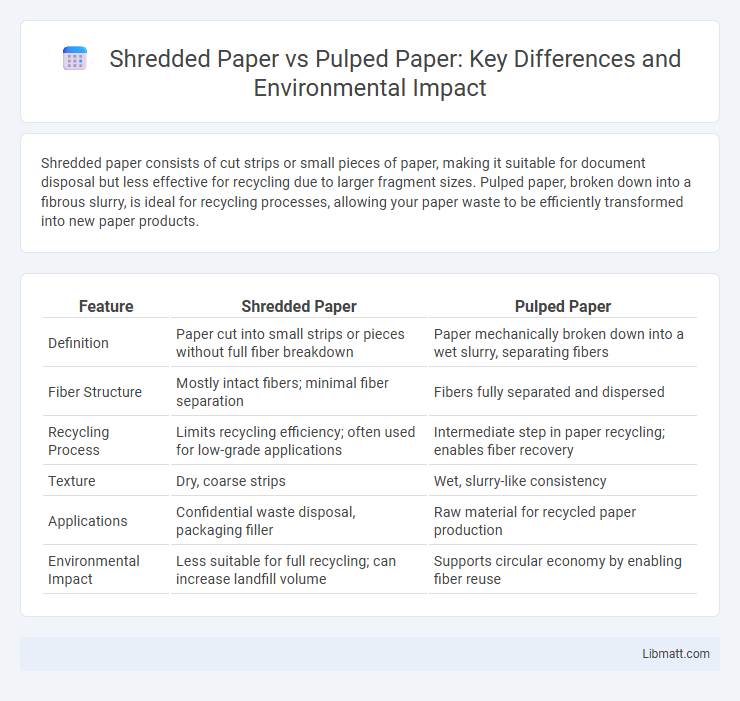Shredded paper consists of cut strips or small pieces of paper, making it suitable for document disposal but less effective for recycling due to larger fragment sizes. Pulped paper, broken down into a fibrous slurry, is ideal for recycling processes, allowing your paper waste to be efficiently transformed into new paper products.
Table of Comparison
| Feature | Shredded Paper | Pulped Paper |
|---|---|---|
| Definition | Paper cut into small strips or pieces without full fiber breakdown | Paper mechanically broken down into a wet slurry, separating fibers |
| Fiber Structure | Mostly intact fibers; minimal fiber separation | Fibers fully separated and dispersed |
| Recycling Process | Limits recycling efficiency; often used for low-grade applications | Intermediate step in paper recycling; enables fiber recovery |
| Texture | Dry, coarse strips | Wet, slurry-like consistency |
| Applications | Confidential waste disposal, packaging filler | Raw material for recycled paper production |
| Environmental Impact | Less suitable for full recycling; can increase landfill volume | Supports circular economy by enabling fiber reuse |
Introduction to Shredded and Pulped Paper
Shredded paper consists of documents cut into narrow strips or particles, primarily used for secure disposal and recycling. Pulped paper is created by breaking down paper fibers into a slurry through mechanical or chemical processes, forming the base material for producing new paper products. Understanding the difference between shredded and pulped paper helps optimize your recycling approach and enhances paper waste management efficiency.
What is Shredded Paper?
Shredded paper consists of paper cut into narrow strips or small pieces, often used for secure disposal of confidential documents. Unlike pulped paper, which is broken down into a slurry for recycling and repurposing, shredded paper retains its original fibers but in a fragmented state. Your choice between shredded and pulped paper depends on whether you prioritize document security or material recycling efficiency.
What is Pulped Paper?
Pulped paper is created by breaking down paper fibers into a slurry or pulp through mechanical or chemical processes, allowing it to be reshaped and recycled into new paper products. This method enhances fiber bonding and results in a smoother, more uniform texture compared to shredded paper. Pulped paper is essential in the recycling industry for producing high-quality, sustainable paper materials.
Key Differences Between Shredded and Pulped Paper
Shredded paper consists of larger, intact strips or pieces cut from documents, retaining some original fiber structure and readability, whereas pulped paper is broken down into a slurry of fibers, losing all original form and text. Shredded paper is often used for low-security disposal or recycling processes that require partial fiber retention, while pulped paper is essential for high-security destruction and efficient fiber recovery in paper manufacturing. The main difference lies in the physical state: shredded paper remains visibly fragmented, while pulped paper is fully disintegrated and recombined.
Security and Confidentiality Considerations
Shredded paper offers a moderate level of security by breaking documents into thin strips that hinder reassembly, but it can be vulnerable to sophisticated reconstruction techniques. Pulped paper undergoes a thorough chemical and mechanical disintegration process, rendering sensitive information completely irretrievable and ensuring the highest confidentiality standards. Organizations prioritizing data protection prefer pulping methods to comply with strict privacy regulations and mitigate risks of information breaches.
Environmental Impact: Shredded vs Pulped
Shredded paper generates more waste volume and challenges recycling facilities due to its inconsistent size and potential contamination, diminishing its environmental benefits. Pulped paper undergoes a thorough reprocessing that breaks fibers down uniformly, enabling higher-quality recycling efficiency and reducing landfill deposits significantly. This controlled pulping process lowers energy consumption and greenhouse gas emissions compared to managing large amounts of shredded paper waste.
Recycling Methods for Shredded and Pulped Paper
Recycling shredded paper involves mechanical processes like sorting, de-inking, and re-pulping to create new paper products, whereas pulped paper recycling begins directly from the fiber slurry stage, making it easier to remove contaminants. Both materials undergo cleaning and screening to remove inks and adhesives, but shredded paper requires additional sorting to prevent short fiber issues. Understanding these differences can enhance your paper recycling efficiency and improve the quality of the recycled output.
Cost Implications of Each Method
Shredded paper generally incurs lower immediate costs due to minimal processing requirements and simple machinery, making it cost-effective for short-term waste disposal. Pulped paper involves more complex processing, including fiber extraction and cleaning, leading to higher upfront equipment and operational expenses but offers long-term savings through enhanced recyclability and reduced landfill fees. Companies should weigh initial investment against sustainability goals and potential revenue from recycled pulp products when choosing between shredded and pulped paper.
Applications and Best Use Cases
Shredded paper is ideal for secure disposal of sensitive documents, packaging filler, and composting due to its longer, fibrous strips that maintain structure. Pulped paper, with its broken-down, slurry-like consistency, is best suited for paper recycling, mold making, and producing recycled paper products by reforming fibers into new sheets. Choosing shredded paper enhances security and cushioning, while pulped paper excels in efficient material reuse and sustainable manufacturing.
Choosing the Right Paper Disposal Method
Shredded paper offers fast and secure disposal for confidential documents but lacks suitability for recycling processes due to fiber damage. Pulped paper undergoes chemical or mechanical breakdown, transforming waste into reusable pulp ideal for sustainable paper production. Selecting the right paper disposal method depends on balancing security requirements with environmental impact and recycling capabilities.
Shredded paper vs pulped paper Infographic

 libmatt.com
libmatt.com